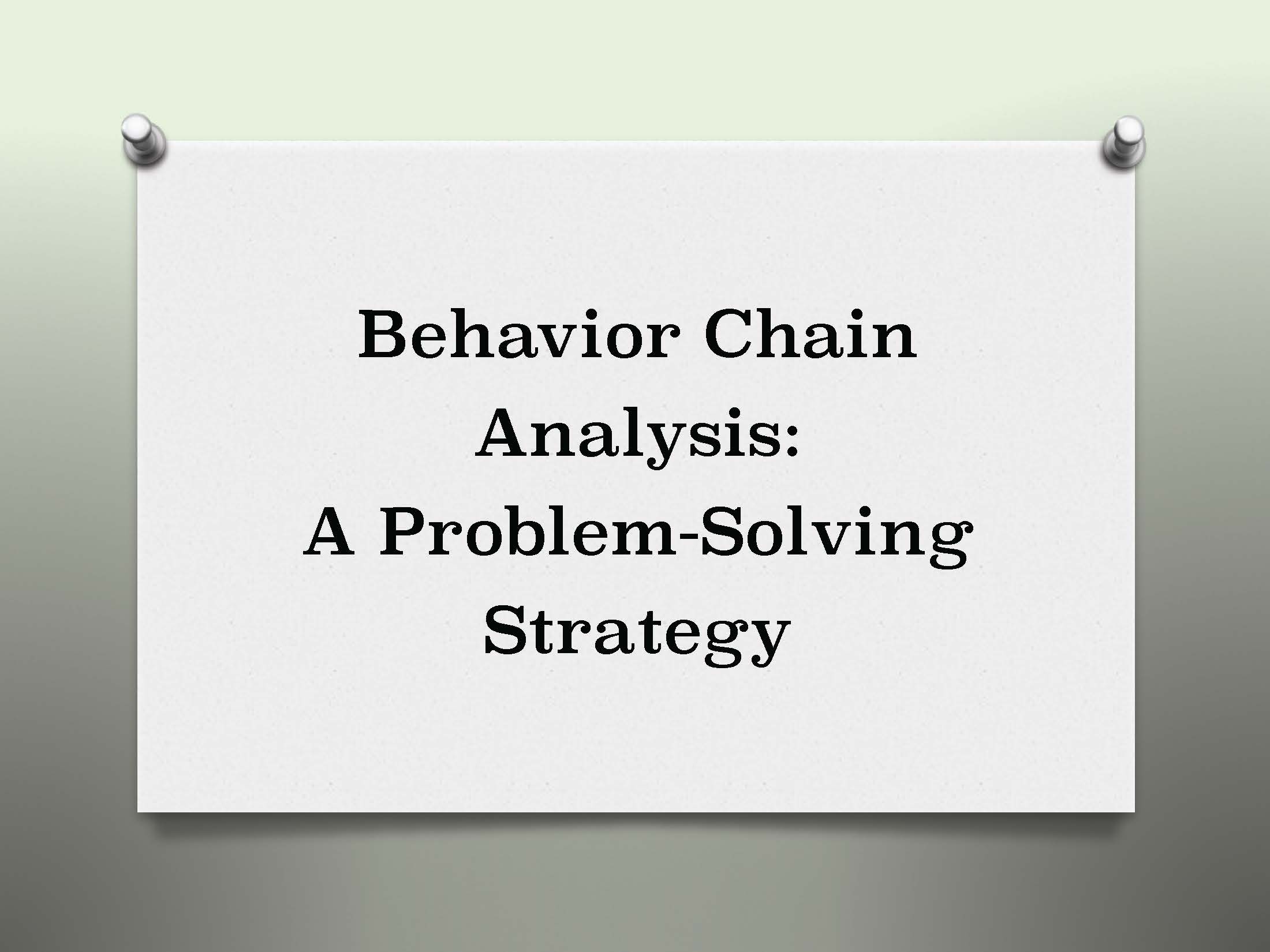- Chain Analysis Formdialectical Behavioral Training Techniques
- Dialectical Behavioral Therapy Certification
- Chain Analysis In Dialectical Behavior Therapy
What is Shaping and Chaining? Shaping and chaining are two helpful techniques that you can use to teach your child many complex behaviors. With shaping, the learner learns by first approximately performing the goal behavior. An introduction to DBT and Chain Analysis of problem behaviors. Behavior DBT Behavioral Chain Analysis Worksheet Name: Date: Target Behavior: Vulnerability Factors E Types of Links: A Actions B Body Sensations C Cognitions E Events F Feelings Things in myself and my environment that made me vulnerable: Ways to reduce vulnerability in the future. Chain analysis helps providers better understand triggers to problem behavior, explore the consequences of problem behaviors, and figure out causes and interventions. Determining if a traumatic event is a contributing factor can provide information about implementation of treatment interventions. Chain analyses is an integral part of Dialectical Behavior Therapy. Regardless of your therapeutic orientation, incorporating chain analyses as an additional assessment feature can.

ABA Training Video
Chaining and task analysis are teaching procedures that helps teach complex behaviors or sequences of behaviors, such as:
- Self-help skills
- Social skills
- Games
- Academic tasks
Each step is taught and mastered and then chained together using backward or forward chaining. Watch the teachers in this autism teaching strategies video use chaining and task analysis to teach complex or multi-step behaviors/skills.
Chaining


Chaining involves breaking a skill down into its step by step componenents. Each step is taught and mastered and then chained together into a larger whole.
Task Analysis
Task Analysis involves breaking complex skills into smaller, teachable units, the products of which is a series of sequentially ordered steps or task.
Applied Behavior Analysis is a popular therapy method used with individuals with autism and related conditions, those interested in the field often inquire what is “chaining” in ABA? Chaining is a method that therapists use to help children gain proficiency in complex, multi-step directions. The method breaks the steps of directions into specific instructions that link together to enable kids to complete the entire task. It involves behavior chains that are strings of individual behaviors that when connected together create a terminal behavior. Chaining involves three main approaches: total task chaining, forward chaining, and backward chaining.
Related resource: Top 20 Online Applied Behavior Analysis Bachelor’s Degree and BCaBA Coursework Programs
Total Task Chaining
Total task chaining involves the child learning the task as a whole as the behavior analyst or parent walks him or her through each step and providing the necessary prompts. As the child goes through attempts to go through the task on his or her own, the analyst or parent constantly repeats the steps. The analyst or parent tells the child every move to make and guides him or her through the actions. The chain is taught until the child is able to complete all behaviors in the sequence correctly. During the task and at the end, the behavior analyst or parent uses praise or supplemental reinforcement to reassure the completion of the correct steps. Total task chaining is the technique used most often to teach functional skills to children with disabilities. The disadvantage of this method is that the supplemental reinforcers at every step need to be diminished as the child acquires the skill. The behavior analyst or parent must provide the strongest reinforcement at the end of the activity.
Forward Chaining
Forward chaining involves the child learning the behavior in the logically occurring order. Every step of the sequence is taught and the child learns the first step independently. Each phase is reinforced when completed correctly. After the first step is finished with a predetermined standard of accuracy, the student is taught the second step of the series with reinforcement depending on the finishing of all the previous steps. When the child can finish the first step successfully, without being prompted, then he or she can start completing the next. Every step builds on the previous to further the reinforcement. Typically, once the first step is successfully completed three consecutive times, the child is taught the next step.
Chain Analysis Formdialectical Behavioral Training Techniques
Backward Chaining
Dialectical Behavioral Therapy Certification
Backward Chaining is defined as the opposite of forward chaining. All behaviors in the analysis of the task are firstly completed by the parent or behavior analyst, with the exception of the final behavior in the chain. When the child performs the last behavior in the series at the fixed benchmark level, reinforcement is provided. Next, reinforcement is presented when the last and the next-to-last steps in the series are performed to standard. The series proceeds backward through the chain until all the activities are introduced in reverse order and practiced accumulatively. The child finishes all steps of a task without any reminders, except for the last one. Depending on the activity, The Behavior Exchange shares how backward chaining has a clear advantage as it directly connects the independent finishing point of the task to the immediate reward or reinforcement. After the child can complete the last step successfully, he or she can work on completing the second to last step.
Chain Analysis In Dialectical Behavior Therapy
Applied behavior analysis is a complex treatment approach that makes a difference in the lives of those with autism and related conditions. The description of total task chaining, forward chaining, and backward chaining help answer the question of what is “chaining” in ABA?
